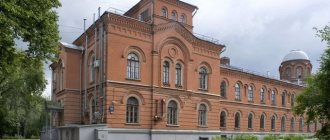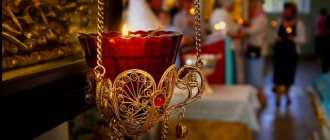The essence of the almshouse
Photo: Cultinfo.ru
In general, an almshouse is a nursing home and differs from it not so much organizationally as in its internal content. Modern almshouses strive to become an abode of the Christian spirit, a place where love reigns in the concept as the Savior bequeathed it to us.
It is here, at the end of their days, that people strive for what they have not had time for all their lives - to think about their soul, to provide it with eternal life and salvation. Whether it is late or early, people cannot know. For everything there is a higher court, which will decide who is worthy of salvation. But it is in the almshouse that all conditions are created for this.
Usually this institution is created at the temple and is located in close proximity to it - this is the second difference from a nursing home.
And formal differences are also observed - here the elderly are called nuns, mothers. The rooms are cells, the dining room is a refectory.
But the main person who lives in the almshouse is not its manager, and not the nuns, but the Holy Christian Spirit, which helps everyone living and working in this institution, sooner or later, realize what Christian relationships are, what true love for God is.
History of development
Like all charitable institutions, almshouses appeared along with Christianity and were initially created at hospitals or even merged with them. The first almshouse was created by the Christian church in 542 in Lyon. In Poland, almshouses have existed for a long time mainly under the name of “parish hospitals”, and only in 1843, when, on the basis of the decree of March 18 (March 2), 1842, there was a systematic and correct division of charitable institutions in accordance with the purposes of their functioning, they were renamed "homes for the aged and infirm." Some of these houses were of very ancient origin. For example, the House of Refuge in Lublin was opened in 1342, in Warsaw the House of the Holy Spirit and the Virgin Mary - in 1388, in Radom - in 1435, in Skierniewice in 1530
In France in the 19th century. shelters for the elderly, infirm and crippled under the name fr. hospices constituted, together with hospitals for curable patients (French hôpitaux), one department of hospitals; institutions in which detainees of both categories were called fr. hospices-hopitaux. Any community had to accept into its almshouses its members who became unable to work; for such communities that did not have almshouses, the general council of the department appointed a certain number of almshouses, inviting these communities to participate in the costs of maintaining such almshouses.
In England, after the reform of 1834, almshouses are branches of workhouses (English Workhouse), which form the basis of the English system of public charity.
The appearance of almshouses in Rus'.
Almshouses came to the territory of Rus' along with Christianity from Byzantium. Already the church charter of St. Vladimir remembers them and entrusts their management to the church. Tithes were determined for the maintenance of monasteries, churches, almshouses and hospitals. For many centuries, the church and monasteries in Rus' remained centers of social assistance to the old, poor and sick.
Following Greek models, shelters for the sick and disabled are established at monasteries and large churches, primarily in the Kiev Pechersk Monastery. Among the monks, there are those who especially devote themselves to caring for the sick and treating them. We can say that in ancient Rus' there was an almshouse at almost every parish church, and at some monasteries entire settlements of beggars were formed.
Prince of Chernigov Nikolai Svyatosha, who was a monk of the Kiev-Pechersk Monastery, built the Trinity Gate Church (1108) and a hospital, on the basis of which the Hospital Holy Trinity Monastery was later formed, where “the blind, lame ...” were collected. In Pereyaslav on the Dnieper in the same 11th century. there was a “bath and treatment building,” where everyone who came was given free medical care. Monasteries in general did not become centers for providing such assistance, although already in the first legislative acts of Rus' after the adoption of Christianity, it was necessary to allocate a portion of all state revenues to the church for these purposes.
Following the Tatar invasion of Rus', the number of crippled, sick, and generally people requiring care increased significantly. But the deep general decline in the economic and cultural life of the people hampered the development of medicine. Relations with Byzantium and the southern and western Slavic peoples are also terminated.
In the middle of the 4th century. Russian lands came under the rule of the Grand Duchy of Lithuania, and from the middle of the 16th century. - As part of the Polish-Lithuanian Commonwealth. Already in 1377, in the city acts of Lvov we find information about the establishment of a hospital in the city for the sick and poor. In the 16th century In Ostrog there was also a large hospital with an annual budget of 4,000 zlotys - a significant amount at that time.
Development of hospitals on Ukrainian lands in the XV-XVIII centuries.
Fraternal Hospital
In the history of almshouses and hospitals in Ukraine, one cannot ignore the brotherhoods - organizations of the Ukrainian philistinism, which in the XV-XVIII centuries. had played a huge role in the life of the people. They were engaged in a variety of religious, charitable and educational activities, helping impoverished and sick members of their parish, and the like. In the description of Paul of Aleppo, from the Patriarch of Antioch, he traveled through Ukraine to Moscow in 1654 p., We read: “Know that throughout the entire Cossack land, in every city, in every village, for their poor, infirm and orphans, a building was built along the edge or in the middle of the populated the places of the house in which they have refuge.” Brotherly shelters already in the 16th century. are called hospitals (from the Latin hospitalis - hospitable).
One of the most significant in Ukraine was the Lviv Brotherhood. The oldest written mentions of it are known from 1439. At the Onufrievsky Monastery, the brotherhood established a hospital in 1522, for which it later received financial assistance from the Moscow Tsar Fyodor Ioannovich. In the suburbs of Lvov, four more small hospitals were opened near Ukrainian churches.
The Kiev Brotherhood was founded later - in 1615. It had its own school and hospital “for poor, old, wise and spiritual people, both secular and knightly people,” as noted in its founding charter.
Fraternal hospitals and schools were maintained at the expense of parishioners. In cities, large workshops kept their hospitals. The smaller workshops were united and had one hospital. In some places, the hospital was supported by customs funds, which were taken for using the city scales, crossing bridges, and ferry crossings. In addition to hospitals, which were maintained with public funds, there were hospitals in Ukraine, the existence of which was ensured by the behests of wealthy individuals; villages, mills and even ham were assigned for this purpose.
Cossack hospital
During the times of the Cossacks, the network of almshouses and hospitals developed even more. The Zaporozhye Cossacks returned from campaigns with a large number of wounded, some of whom remained permanently disabled. For these reasons, the Cossacks were forced to have their own hospitals.
The first such hospital was founded in an oak forest on an island between the Staraya and New Samara rivers. Houses and a church were built there, surrounded by protective ditches. At the request of the Cossacks from Kyiv, Hieromonk Paisius was invited to this hospital, who, in addition to spiritual duties, was also responsible for treating the disabled and wounded. At the end of the 16th century. The main hospital of the Cossacks became the hospital in the Trakhtemirovsky monastery on the Dnieper, below Kanev.
There were military hospitals in the Lebedinsky monastery near Chigirin, Levkovskaya near Ovruch, and Mezhigirsky near Vyshgorod. The monasteries willingly took care of the Cossacks, since they had material profit from this. In Cossack hospitals, as opposed to civilian ones in cities and villages, not only the disabled found shelter; wounded and maimed Cossacks from the Sich were also treated here. These were the original first military medical institutions in Ukraine. After 1755, the hospital in Mezhyhirya at the Mezhigirsky Monastery was supposed to be turned into a public home for the disabled. However, such a house was built in the Kirillov Monastery in Kyiv, and a military hospital was ordered to be opened in Mezhyhirya, which in 1787, on the day of the planned visit of Catherine II to Mezhyhirya, burned down for unknown reasons.
On the number of hospitals in Ukraine in the 17th and 18th centuries. it is possible to create a representation of the information from the revision books of the Left Bank Ukraine in the archives of the Little Russian Collegium. According to these books, in 1732 the Chernigov regiment had 118 hospitals, Lubensky - 107, Mirgorodsky - 29, Nezhinsky - 138, Poltava - 42, Pereyaslavsky - 52. All these hospitals had an opiate purpose.
Development of almshouses under the Russian Empire
After the annexation of Ukrainian lands to the Russian Empire, issues of the functioning of almshouses were resolved at the imperial level. Thus, Peter I, who, persecuting begging and prohibiting private charity, ordered in 1712 the establishment of almshouses in all provinces for the elderly and crippled, capable of working, and in such monastic and church almshouses, first of all, he wanted to place the elderly, wounded and crippled military officials, and to retain them he ordered to give them donations and cash salaries; Candle collections are ordered to be used to build almshouses at churches for begging the sick. In 1723, it was ordered that crippled and infirm people incapable of work, who were identified during the preparation of audits, should not be included in the salary list, but sent to an almshouse. This order, despite its usefulness, turned out to be impossible due to the insufficient number of almshouses. Church funds turned out to be insufficient for the formation and maintenance of almshouses, and the hopes that Peter placed in this matter on the city magistrates he created were not justified.
That is why, under the successors of Peter I, with the Decrees on the province, decrees were constantly repeated both on the persecution of begging and on the creation of almshouses. The decree on the provinces of 1775 contained an attempt to organize this matter on a completely new basis, which turned out to be almost unrealizable. The organization and management of the almshouse was entrusted to the Order of Public Guardianship created in each province. The orders were instructed to establish almshouses in cities and towns, separate for men and women. In addition to the crippled and elderly, hitherto the almshouses were ordered to accommodate: tramps and criminals exiled to Siberia, if due to old age and illness they cannot go there, cripples, retired lower ranks, captured from begging, people who are excluded from the ecclesiastical department for vices and due to illness and old age are able to earn a living by work and the like.
With such a “contingent” and with poor administration, most almshouses were in a very unsatisfactory condition before they were transferred to the jurisdiction of zemstvos (1864) and cities (1870). To improve the state of affairs, zemstvo assemblies first of all began to care about sending only the helpless poor to almshouses; some of them (Kostroma, Nizhny Novgorod, Kharkov) petitioned for the abolition of the mandatory sending of tramps to zemstvo almshouses. At the same time, zemstvos began to take care of orphans in almshouses, about expanding the categories of people who could be there, about establishing new almshouses, and many of them managed to bring these institutions into a completely different form.
After the October Revolution of 1917, the process of disappearance of the concept of “almshouse” began. This is due, first of all, to the closure and liquidation of churches and monasteries, which had many such institutions. Also, zemstvos were abolished, and the institutions that were under their jurisdiction, including almshouses, came under the jurisdiction of Soviet authorities and were either closed or repurposed into “Retirement Homes,” “boarding schools,” “shelters,” etc.
How is it different from a nursing home?
Photo: Miloserdie.ru
How can you immediately distinguish a church establishment from a secular one? Of course, there are external differences - in the almshouse there are icons everywhere, you can often meet priests and novices or nuns. But they are not a mandatory attribute.
It cannot be said that it is always good in an almshouse and always bad in a social welfare institution. And secular nursing homes can provide their clients with good care, polite, correct treatment and excellent living conditions. If there are no loved ones, or they cannot provide comfort and care for the elderly, then a social institution takes on this function. But the main thing in it is still the material part of life - food, clean linen, medical care.
That is, before leaving for another world, people again think about the wrong thing. They discuss not how calm and light their souls are, but what kind of porridge they had for breakfast, and whether their duvet covers will soon be changed... They don’t think about the eternal, but about the mortal. And there is no one to help direct their thoughts in the right direction, so the emptiness is filled with vanity, which tomorrow no one will need. This is the main difference, and it radically changes the idea of how to spend the last years of your life.
One of the versions
As mentioned earlier, the original meaning of this concept was completely different and did not have a negative semantic connotation at all. If history is to be believed, an almshouse is just a shelter for the homeless, the elderly and the disabled. Such people received a roof over their heads, food and the necessary assistance in general.
A shelter for homeless people is not the most profitable establishment, and therefore most often they were organized on a charitable basis and mainly at numerous churches. This is how the root “god” appeared in the word.
The purpose of creating almshouses
Photo: Nne.ru
Hence the goal is clear - to create conditions when old people can come to a deep, unshakable faith and in it prepare for eternity. Think about it, remember what prevents them from standing before the Court, without sadly bowing their heads under the weight of their sins. Have time to repent, work for the good of your soul. Spiritual labors are in no way easier than physical ones, and sometimes even much harder.
But caring for the soul cannot be separated from caring for the body. Cleanliness, satiety, constant grooming - these are what are an integral part of the almshouse. After all, the body is the container of the soul and it also needs to be looked after, preserved, but not forgotten that it is secondary.
Chapter III. EMPLOYEES
- STAFF AND ASSISTANTS OF THE ALMSHOUSE
The staff of the almshouse is growing gradually as the project develops. Moreover, in each specific almshouse it will be different - both in content and in quantity.
Here, for example, is a list of staff members for a small apartment almshouse, which is not a separate legal entity:
- nursing sisters;
- cook;
- laundresses;
- elder sister.
And here is a list of employees (including those working as part-time workers) for a large almshouse, which is a legal entity:
- manager (director, manager) - a person relieved of other duties who organizes the entire life process of the almshouse;
- administrator (deputy, commandant, head nurse, etc.): oversees the internal life of the institution, is responsible for the current work;
- accountant;
- nursing sisters;
- a doctor who can work part-time and visit the almshouse 1-2 times a week;
- cook and his assistant;
- cleaners and nurses;
- housewife sister;
- laundress;
- technical employee: solves technical problems for the operation of the house;
- supply driver.
If the almshouse is large, then it can afford to have a carpenter (often it is necessary to hang a shelf, repair a lock, etc.), an electrician, and a plumber.
The staff of a church almshouse must be selected very carefully. In order for a newcomer to join the team and act with it in the same spirit, the person must be a church member and undergo a mandatory interview with the elder sister and the confessor of the almshouse.
The manager must be able to understand why the employee came to work: just to earn money or to serve others. If there is no second motive, he will not be able to work in the almshouse.
Volunteers usually provide a lot of help to almshouses. There are almshouses (as a rule, at churches and monasteries), in which all work is organized by volunteers. But even with full-time employees working for a salary, the need for volunteer participation remains: to cut grandmothers’ hair, take them to church, congratulate them on the holiday, and even just chat. It is better for a group of “friends of the almshouse” to be formed - i.e. so that one or another volunteer could be a kind of “personal friend” of the grandmother, thereby expanding her circle of contacts.
- SISTERS
Range of duties
It is no secret that the personnel issue when organizing an almshouse is one of the most pressing: where to find those willing to take care of the elderly for a low fee, and how to teach them to do it competently? As we have already said, the idea of creating an almshouse, as a rule, arises in the depths of an active sisterhood or an active group of parishioners already engaged in works of mercy: helping the elderly or
seriously ill parishioners, orphans, disabled people, etc. So the physically strong parishioners or members of the sisterhood involved in such work are the almshouse’s personnel pool.
The age of the sisters can be different: young people also work well, and they are passionate about caring for infirm people: they have a lot of strength, they learn everything quickly, they are eager to help. But mature people in such work are good in their own way: they can give the residents what they have learned from their experience; they put their children on their feet and they may have some kind of support: a working husband who provides for the family.
Both of them can become wonderful sisters if they have the strength and want to serve the sick.
As for the professional training of nurses, this problem can also be solved. Nowadays, nursing courses are organized for the population in many places. In some cities there are Orthodox patronage courses at schools of nurses or sisterhoods. In Moscow, for example, free courses for patronage nurses are constantly running at the St. Demetrius School of Sisters of Mercy. After all, it only seems that there is nothing complicated in caring for the sick. In fact, there are many skills and knowledge, the use of which affects both the patient’s condition and the health of the nurse herself. How to prevent bedsores and congestion in the lungs in sedentary patients? How can you avoid injuring your spine and learn how to properly distribute the load by helping the patient sit down, stand up, etc. many times every day? The sister is taught all this in courses that last several (usually eight) months and involve not only theoretical classes and seminars, but also practice. Anyone who wants to become a sister of mercy and stay to work in one of the projects of the St. Demetrius Sisterhood (in an almshouse, an orphanage for disabled children, etc.) can take the course. You can sign up for courses by calling: +7 (495) 972–97-02.
If a new sister is accepted into the almshouse, having the necessary education, but without experience, then she must undergo training on the job. On average, such training lasts from one to three months. Although it happens that a newcomer understands on his first working day: this job is not for him. For those who remain, after the first two or three visits, a salary begins to accrue as an intern. The intern for training is assigned to a long-time working nurse, whose experience in caring for and treating the sick would like to be replicated.
So, what medical actions should a nurse working in an almshouse be able to perform:
—properly care for the patient, without causing him harm or pain, and without harming one’s own health;
—measure pressure, temperature, pulse;
—monitor changes in the patient’s condition in order to make a timely decision about the need to call an ambulance or a local doctor;
—give patients medicine in accordance with the doctor’s prescription sheet, understand the dosage, and navigate the side effects of the drugs;
- do simple dressings; - It is advisable to be able to give injections.
In addition to the duties of a nurse, a nurse provides direct patient care in the almshouse:
- feeds the sick;
— carries out hygiene procedures: washes, washes, turns over, makes the bed, etc.;
-cleans and disinfects the room.
For many inmates of the almshouse, a sister of mercy is not just an employee, but a close, dear person with whom you can talk, share joy or cry. In the St. Spyridonievskaya almshouse, grandmothers often ask in advance who will be on duty the next day, and tune in to each sister in a certain way. The sisters try to read something to the grandmothers, bring them a CD to listen to, and caress them. It is thanks to this informal communication between nuns and sisters that a special atmosphere is ultimately created in the almshouse, which allows older people not to feel abandoned, lonely, and useless to anyone. The initiators of such communication should be sisters, who ideally should love their charges in a Christian way.
One of the sisters may work part-time as a social worker in an almshouse. This work is not associated with daily stress and does not require special professional skills.
The permanent responsibilities of a social worker include, for example, contacts with the district clinic, to which all the inmates of the almshouse are assigned: it is necessary to register or deregister wards, receive free medicines, diapers, etc.
Care
The skill of caring for a weak person is one of the main things in the work of an almshouse employee. Nursing skills are important for both the patient and the nurse. For the patient, all manipulations should be done easily and not painfully. And my sister needs to protect her health while caring for her.
In the St. Spyridonievskaya almshouse, there are algorithms of actions that have been worked out for years: how to transfer a bedridden patient to a chair, how to change the underwear under him, how to wash him.
The care regime here is approximately as follows:
- wash bedridden residents twice a day in bed. Those who can walk to the toilet themselves are helped to perform morning procedures there;
— in the morning, in addition to washing, all children in their care wash their armpits, chest, and back with a pre-prepared solution of baby soap. The good thing about the solution is that it does not require water when soaping and, unlike ready-made liquid soap, is easily washed off with a soft towel. The skin becomes clean, as after washing in the shower, and the bed remains dry (To prepare the solution, you need to take baby soap without perfume, grate it on a coarse grater, place it in a closed container and pour boiling water at the rate of 4 tablespoons of soap per standard jar in 650 ml, or 500 ml of soap - per 5 liter canister. Stir thoroughly so that there are no lumps left, let cool. You will get a thick dense mass that can be poured through a funnel into a dispenser and used daily. Shelf life - three weeks);
- once a week, each nun has a big bathing day. The grandmother is transferred to a wheelchair, and the sister in an apron washes her right in the chair. At this time, the second sister must have time to wash the bed and change the linen;
— bed linen is changed once a week. The sheet should be taut, like the skin on a drum, so that even the corners of the mattress curl slightly. Then the sheet under the mattress is tied (that's why wide sheets are used). Otherwise, if there is even a small fold under the body, bedsores may form in this place;
- they sit down bedridden patients several times a day - during meals, after meals they sit as long as they can;
- not everyone can turn over on their own - during the day, bedridden patients need to be turned over several times, so that, again, there are no bedsores. If even a barely noticeable red spot appears, you need to smear it with a nourishing cream and massage around this place.
One of the main principles in nursing: those who can sit at least a little should sit; those who can walk even a little should definitely do so every day.
Working hours and payment
The sister's work in the almshouse is shift work. The optimal work schedule for a nursing sister is as follows: every three days or 12 hours every two days (from 8.00 to 20.00 - day shift, from 20.00 to 8.00 - night shift). In the St. Spiridonian almshouse, with this schedule, the rate is 120 working hours per month. This is 10 shifts of 12 hours each (the usual city rate is 160-170 hours per month). According to the experience of this almshouse, 18 sisters are needed for 12 residents (taking into account the fact that one of the sisters may get sick). Somewhere they make do with fewer nurses, but this reduces the quality of care and increases the workload on employees.
During the night and day shifts, the number of nurses on duty is different. So, for example, in the St. Spiridonievskaya almshouse, two sisters work per floor during the day shift (there are three patients for each), and one sister per floor during the night shift. It seems that working at night is calmer: everyone is sleeping. But the night nurse herself works: first, she must help the patients calm down and fall asleep, then clean the bathrooms, and then work with documents, in particular, check and rewrite doctor’s prescription sheets. In addition, emergency situations also happen: for example, someone may have a seizure at night.
The sister's salary does not depend on whether she works day or night, but only on the number of hours worked. When paying for labor, it is also correct to take into account the sister’s professional education: the higher it is, the higher the hourly wage (for example, it makes a difference whether the sister only graduated from nursing courses or medical school). In general, tariffs should be developed by the organization on whose budget the almshouse will be located.
Work specifics
Compared to the work of a nurse in a hospital, where there is a flow of different people with different problems and conditions, work in an almshouse is incomparably more monotonous. It seems that in the hospital you grow professionally, gain new skills and knowledge. And in the almshouse, the same patients who have the same problems are waiting for you every day. Diversity is sometimes brought about by a sharp deterioration in the condition of the nuns, which in no way alleviates the situation, but on the contrary requires you to exert all your internal forces in order to react quickly and accurately.
A sister in an almshouse combines in her work the work of a nurse, a nurse, a nurse and, to top it all, a nanny and a friend who is ready to talk, read, and entertain. Therefore, such work often results in rapid professional burnout.
In the prevention of this condition, an important role is played by the spiritual nourishment of the almshouse employees, which will be discussed in Chapter V (Part 2 “Spiritual Nurturing”).
How not to burn out?
The work of a nursing sister is hard. There are those who leave, losing their health. But there are those who work for 10 years or more. According to Olga Iordanskaya, senior sister of the St. Spyridonievskaya almshouse, it is important to have professional care skills so as not to harm your health; know your limits, participate in liturgical life; take regular rest, be sure to go on vacation somewhere: “If you work normally and have your own personal life, there will be no burnout.”
The atmosphere among the almshouse staff is very important. If she is warm, friendly, if sisters help each other and support each other, then their work is much easier.
- ELDER SISTER
If global issues in the almshouse are decided by the confessor and director, then the elder sister is responsible for solving daily internal problems. In many almshouses, she is the main administrative person of the almshouse, as well as the link between the founder of the almshouse (sisterhood or parish) and its employees.
The elder sister interacts with government authorities on issues related to the affairs of the almshouse. She receives the nuns' pension. She also draws up the duty schedule for the sisters and ensures that order is maintained.
- SISTER IN THE LAUNDRY ROOM
In addition to the sisters who care for the nuns in the almshouse, the establishment must have a sister on staff who will do the laundry every day. Now this work can be largely automated (due to washing machines with automatic dryers), but with the number of nuns being 10 people, even with an automatic machine, a sister is needed specifically for this work. So, for example, in the St. Spiridonian almshouse (now there are 12 wards) - every day, except Sunday, someone has a bath day with a change of all bed and underwear. Work in the laundry is done in shifts, like ordinary nurses, only without night shifts. Shift is 10–12 hours, pay is hourly. With this mode of work, 12 wards need three laundresses replacing each other.
You can work as a nurse in a laundry without a medical education, since her responsibilities only include washing and drying bed linen and clothes of residents, and, if necessary, darning and mending clothes. Clean linen is laid out daily in the residents' chests of drawers.
- COOK
The kitchen is another place in the almshouse where you can work without a medical education, but it is advisable to have professional cooking skills, in particular to be familiar with dietary cuisine.
There, three cooks work in shifts for 12 clients and 6 employees. Their responsibilities include feeding sisters and grandmothers, washing dishes, and purchasing food from the hypermarket (where prices are lower than in neighboring grocery stores). Large purchases are made approximately once every two weeks. If you need to buy something in addition, the cook uses nearby stores. Even if you have a small almshouse, one person in it cannot cope with all the cooking. At least two are needed so that they can work every other day or two days after two, as happens in the St. Spiridonian almshouse.
- DOCTORS
The inmates of the almshouse need regular consultations with a doctor. Therefore, all grandmothers need to be assigned to the district clinic, to which the almshouse is located.
True, in the clinic the situation with doctors is different. For example, the St. Spiridonian almshouse was first served by an experienced doctor, an excellent diagnostician, and after he transferred to another job, doctors began to change almost every two weeks. In such a case, it is good to have another specialist who would systematically observe the nuns. Perhaps there will be such people in the parish or in the sisterhood.
The doctor can work part-time and visit the almshouse at least once or twice a week. In all emergency cases, it is necessary to call the local doctor, since the local doctor will officially treat the patients of the almshouse (come to the call, prescribe medications, make appointments, hospitalize the patient in a special medical institution, declare death). The best option is if the local doctor works part-time in an almshouse.
In addition to a therapist, an almshouse usually requires regular assistance from a psychiatrist. If there is no such specialist in the district clinic, then you can try to find him in private clinics and invite him to the almshouse on a commercial basis. It happens that grandmothers have a serious mental state caused by sleep disturbances. A good psychiatrist, with the help of medications, can correct the situation so that old people are active during the day and sleep at night. Sometimes simple treatment has a good effect: the nuns become noticeably calmer and more adequate. But you need to be prepared for the fact that the drugs prescribed by a psychiatrist can be quite expensive. In the St. Demetrius Sisterhood, for example, there is a benefactor who pays monthly only for psychiatric medications.
Who works in this establishment?
Photo: Miloserdie.ru
Of course, the contingent in the charitable institution is very different. All people come here with a certain baggage of life habits, experience and their own formed characters. But those who work here address each other as “mother, sister, father,” thereby defining the circle of this family of Christ.
The main quality, therefore, for workers and almshouse staff is patience. True Christian patience, which the Lord defined as a test of true faith. It is difficult for those who work in this establishment. After all, financial well-being does not always allow you to do everything as you would like. You have to infringe on yourself in many things, sometimes it seems that you are running into a wall. But if you endure, then suddenly everything resolves itself, according to the Will of God. This is the reward for passing the test.
It is not easy to put up with the ingratitude and intransigence of those who begin life in an almshouse. Not all the inhabitants immediately become meek and God-fearing, as if by magic. They re-educate themselves, breaking away from the roots of sprouted sins, but the process is long and not even for everyone has time to complete.
How to get to the almshouse for accommodation?
Photo: Vrataby.com
A person who seeks to end his days in the spirit of the Orthodox faith and under the shadow of a temple can find such an institution for himself not far from his place of residence. To do this, it is best to seek help from the nearest temple, and they will help you decide on the direction of your search. There is a special employee at the almshouse who is responsible for the selection and placement of new family members. He will also help you prepare all the documents, help with the move and arrangement. Many almshouses have their own website, so with the help of friends or on your own you can find such an institution.
further reading
- Caffrey, Helen (2006). Almshouses in West Yorkshire 1600-1900
. King's Lynn: Heritage. ISBN 1-905223-21-8. - Clay, Rotta Mary (1909). Medieval Hospitals of England
. - Public domain text including daily life, care and "The Office of the Leper's Isolation" - Goose, Nigel; Caffrey, Helen; Langley, Anne, ed. (2016). The British Almshouse: New Perspectives on Charity c.
1400-1914 . Milton Keynes: Family and Community Historical Research Society (FACHRS). ISBN 978-0-954-81802-9. - Heath, Sidney (1910). Old English Alms: An Illustrated Record with Architectural and Historical Notes
. London: F. Griffiths. - Hopewell, Peter (1995). Holy Cross: England's Oldest Almshouse
. Chichester, England: Phillimore. - Rothman, David J., ed. (1971). Almshouse Experience
. Poverty in the United States: A Historical Record. Arno Press. ISBN 0-405-03092-4. - "Life history of older people." SeniorLiving.org
.
Modern Russian almshouses
Photo: Stdimitry.ru
We should talk about several establishments that exist in our time.
St. Spiridonyevskaya almshouse
Initially it was a small shelter, consisting of only two apartments in a residential building. Now the almshouse is located in a new, separate building on the embankment of the Yauza River. Here, the nuns of the St. Demetrius Sisterhood provide care for the residents. Many of the residents have serious illnesses. The fact is that this sisterhood is licensed nursing, so they can treat diseases. But the main thing is that they treat bodies simultaneously with the treatment of souls. They help morally, talk to people, are sincerely interested in their state of mind, share their pains with them, empathize with their weaknesses and strengthen the inhabitants, and help them heal.
Ekaterinburg almshouse
There is a similar almshouse in an ordinary residential building in Yekaterinburg. She bears the name of Grand Duchess Elizabeth Feodorovna. It has a small staff and provides medical services through a local clinic and by volunteers.
Gallery
- Almshouses in Liers, Belgium
- Almshouse at the parish church of St. John's in Thaxted, England
- Almshouse in Woburn, Bedfordshire, England
- St Mary's Almshouses (north wing), Church Lane, Godstone, England
- Almshouse cottages built in the early 1900s. Whiteley Village, England
- Queens' College, Cambridge, England, almshouses in 1912
- Royal Albert Homes, Cambridge, England
- Boshuisengasthuis
in Leeuwarden, Netherlands
- Nieuw Sint-Anthony Gastuis
in Leeuwarden, Netherlands
- Swanenburghshof
in Gouda, South Holland











